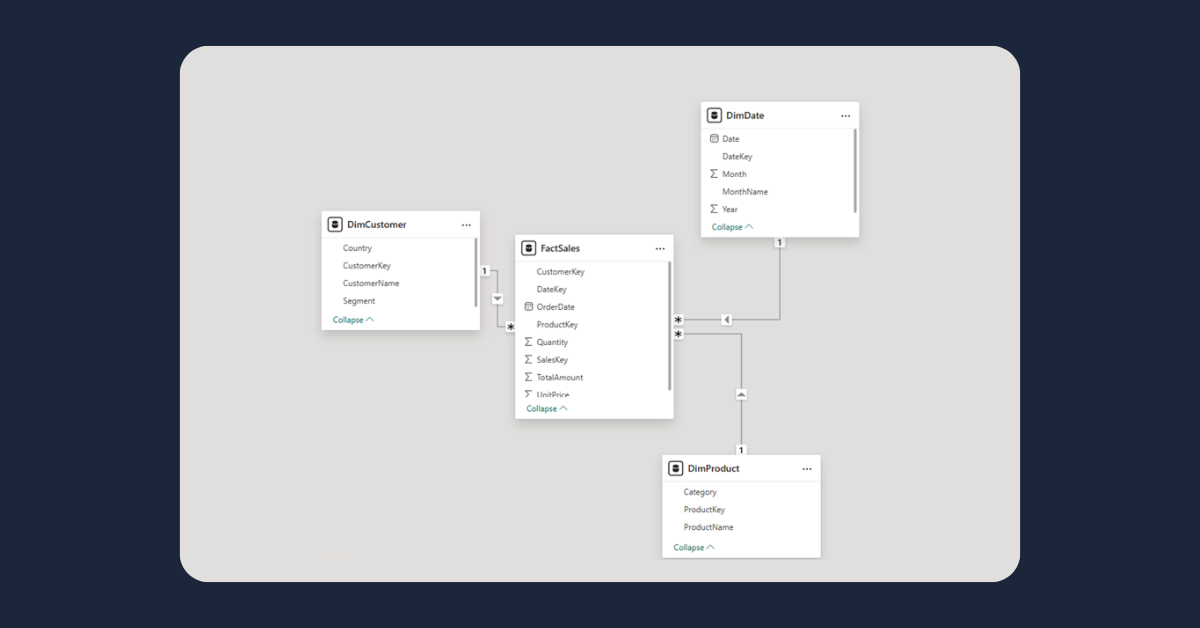If you're scaling Power BI across teams, you've likely felt the pain: duplicate datasets, inconsistent KPIs, opaque refresh failures, and security questions that arrive five minutes before a board meeting. This guide explains Power BI data governance-people, processes, and tools-and shows how to move from ad-hoc dashboards to a governed self-service BI model. You'll also see how Dataedo closes the governance gap with a catalog, business glossary, and end-to-end lineage from sources to Power BI dashboards.
Why Power BI governance matters - the industry problem
As organizations expand Power BI adoption across teams and departments, what starts as agile self-service can quickly turn into chaos if growth isn't managed.
Uncontrolled growth leads to:
- Shadow BI & duplicate models: multiple "truths" for the same KPI.
- No shared language: measures and DAX differ by team; documentation lives in people's heads.
- Unclear ownership: who maintains a dataset, approves changes, or fixes refresh issues?
- Invisible lineage: difficult to answer "where did this number come from?" and "what breaks if we change X?"
- Security & compliance risks: missing RLS, sensitivity labels, and auditability.
- Operational blind spots: refresh failures unnoticed, orphaned datasets, runaway costs.
A structured Power BI governance framework solves this by standardizing roles, processes, and artefacts, then supporting them with a data catalog, glossary, and lineage.
A simple data governance framework for Power BI
A solid Power BI governance framework connects people, processes, and tools to create a balance between control and agility. It defines who is responsible for data assets, how content moves from development to production, and which artefacts make governance visible and repeatable.
The framework can be implemented step by step:
- Define roles - assign ownership and stewardship across domains.
- Establish processes - set standards for lifecycle, endorsement, and access.
- Deploy tools and artefacts - organize workspaces, models, and lineage to support transparency.
Together, these elements turn governance from theory into a practical operating model that teams can follow day to day.
People & roles
Effective governance starts with clear ownership.
Defining who does what ensures accountability for data quality, documentation, and platform management - so issues don't fall through the cracks.
- Data Owner - accountable for data quality and access decisions.
- Data Steward - curates definitions, maintains metadata, drives adoption.
- BI Developer / Modeler - builds semantic models, DAX, dataflows.
- Report Consumer / Analyst - uses certified content, proposes improvements.
- Platform Lead - manages workspaces, gateways, pipelines, capacity.
Policies & processes
Once roles are clear, consistent processes keep everything running smoothly.
Policies define how Power BI content moves from idea to production, how changes are controlled, and how security and trust are maintained over time.
- Lifecycle: DEV → TEST → PROD using deployment pipelines (versioning, approvals).
- Change control: pull requests/reviews for DAX and model changes; impact analysis before releases.
- Endorsement: Promoted vs Certified datasets/reports with clear criteria.
- Access & security: RLS/OLS patterns, sensitivity labels, data-sharing rules.
- Monitoring: refresh SLAs, alerts, usage analytics, periodic clean-ups.
Tools & artefacts
People and processes need support from the right tools.
Catalogs, glossaries, lineage diagrams, and structured workspaces make governance tangible - turning standards into everyday practice.
- Workspaces structured by domain/product.
- Semantic models (datasets) as shared, governed sources of truth.
- Dataflows for reusable transformations.
- Endorsements & labels for trust and compliance.
- Catalog + glossary + lineage to make governance visible and usable.
How Dataedo closes the Power BI governance gap
Even with best practices in place, many organizations still struggle to make governance visible and actionable inside Power BI. Metadata lives in silos, definitions drift across teams, and lineage is often incomplete or hard to trace. This is where Dataedo bridges the gap - by providing a unified layer of documentation, business glossary, and end-to-end lineage that connects technical assets with business meaning.
With Dataedo, governance becomes part of everyday BI work: users can discover certified datasets, understand calculations, trace data to its source, and see who owns what - all without leaving their workflow.
1) Data catalog + business glossary
Create a central catalog of datasets, tables, columns, measures, and reports. Define business terms (EBIT, Churn Rate), link them to DAX measures and columns, and make the definitions discoverable for everyone. This harmonizes language across teams and reduces interpretation drift.

2) Documentation for datasets and DAX
Document semantic models: purpose, owners, data domains, refresh schedule, RLS roles, and data classifications. Attach descriptions to measures and calculated columns. Use tags and domains to organize content.
3) End-to-end lineage & impact analysis
Map lineage from source systems (SQL, ETL, dataflows) through Power BI semantic models to reports and dashboards. Run impact analysis before changing a column, dropping a table, or renaming a measure-see exactly which models and reports will be affected.

4) Quality & compliance context
Mark sensitive fields (PII/PCI), specify retention rules, and include data quality notes. Keep an auditable trail of updates and stewards.
5) Governed self-service
With a visible catalog and lineage, teams can reuse certified datasets and measures instead of rebuilding them. Governance becomes an enablement layer: self-service with standards, not a bottleneck.
Book a short demo or start a free trial to turn chaos into trusted insights - fast.
Power BI governance best practices - checklists & quick wins
Even with a framework in place, governance only works if it's practiced consistently. These best practices translate the framework into actionable steps and quick wins you can apply to existing Power BI environments. Each area includes a short checklist you can use to validate maturity and prioritize improvements.
Model standards - semantic model governance
A governed Power BI ecosystem starts with consistent, well-documented semantic models. Clear naming, descriptions, and calculation standards make datasets easier to understand, reuse, and trust across teams. These practices turn your models into shared, auditable sources of truth.
- Naming conventions for tables, columns, and measures (e.g., Total Sales with Format = Currency).
- Descriptions for datasets, tables, columns, and measures (synced to the catalog).
- Calculation logic documented (DAX intent, grain, filters).
- Endorsements: only publish to PROD when criteria are met (tests, owners, lineage).
Quick win checklist
Use this to confirm whether your semantic models meet minimum governance standards.
- Every certified dataset has an Owner and Steward.
- All measures have a business description and format.
- RLS roles are documented and tested.
- Dataset SLA (refresh frequency, window) is published.
Lineage & change control
Understanding and controlling how data moves through Power BI is essential for safe updates and impact analysis. Lineage documentation and version control help prevent accidental breaks and keep downstream users informed.
- Document flows: source → transform (ETL/dataflow) → model → report.
- Impact analysis before schema changes (columns, data types, names).
- Versioning & approvals: code review for DAX, parameters, and relationships.
Quick win checklist
Use this checklist to ensure lineage and change control are consistently applied across your Power BI environment.
- Lineage diagrams show dependencies for key datasets.
- Change tickets include documented impact analysis.
- Breaking changes have communication plans for downstream consumers.
Security & compliance
Governance also protects sensitive data. Standardized RLS/OLS, clear sharing policies, and data classification ensure compliance without slowing down collaboration.
- Apply RLS/OLS centrally and validate with test users.
- Use sensitivity labels and mark sensitive columns in the catalog.
- Define sharing policies (internal/external) and workspace access patterns.
Quick win checklist
Use this to verify that Power BI access and compliance controls are in place.
- RLS/OLS mapped to documented user groups.
- Sensitive columns tagged and visible in the catalog.
- Sharing only from PROD workspaces using certified content.
Operations & monitoring
Reliable operations keep governance alive day to day. Monitoring refreshes, usage, and capacity ensures stability and helps identify redundant or failing assets early.
- Set refresh SLAs; alert on failures and long durations.
- Review usage metrics quarterly; archive unused datasets/reports.
- Track capacity (Premium/Fabric) and gateway health.
Quick win checklist
Use this checklist for ongoing operational reviews and quarterly clean-ups.
- Alerts for refresh failures and thresholds.
- Quarterly content hygiene (unused, duplicate datasets).
- Gateway status dashboards (online, version, data source mapping).
Example scenarios - where governance pays off
- Finance: one KPI glossary + certified measures (e.g., Revenue, EBITDA) eliminates number debates across regions. Lineage proves exactly which ERP fields and adjustments feed the KPI.
- Sales & operations: DirectQuery models reuse a certified conformed dimension set. Dataedo lineage shows downstream reports before a schema change hits production.
- Compliance: sensitive fields (PII) are tagged; RLS/OLS patterns are documented. Auditors can trace data from source tables to visuals in minutes.
- Modernization: multiple shadow datasets are consolidated into a single certified semantic model; teams build reports on top instead of cloning logic.
Step-by-step: start Power BI governance with Dataedo (mini-tutorial)
Getting governance up and running doesn't have to be a massive project - you can start with a focused pilot and gradually scale. This mini-tutorial walks you through five practical steps to bring your Dataedo solution into your Microsoft Power BI ecosystem. By following this sequence, you'll connect your metadata, build a shared business glossary, map lineage from sources to reports, and enable reuse of certified datasets. What begins here will give you the foundation for governed self-service BI across your organisation.
1) Inventory & connect
Ingest sources (SQL Server, dataflows, semantic models). Discover tables, columns, measures, and relationships. Auto-populate initial metadata.
Outcome: a browsable catalog of your Power BI estate.
2) Build the business glossary
Define key terms (e.g., Net Sales, Active Customer). Link terms to DAX measures and columns. Capture calculation rules and exclusions.
Outcome: a shared vocabulary, visible right where people search.
3) Enrich documentation & ownership
Add owners, stewards, tags, and sensitivity. Write concise descriptions for datasets, tables, columns, and measures. Add refresh SLAs and RLS notes.
Outcome: everyone knows who to ask and how it works.
4) Map lineage & run impact analysis
Generate lineage from source systems to reports. Before changing a column or measure, check which models and visuals depend on it; plan changes safely.
Outcome: fewer incidents, predictable releases.
5) Publish & drive adoption
Expose the catalog to analysts; align Promoted/Certified status in Power BI with catalog entries. Encourage reuse of certified datasets instead of recreating metrics.
Outcome: governed self-service with less duplication.

Build a governed Power BI ecosystem with Dataedo.
Document your semantic models and DAX, align everyone on a shared glossary, and see end-to-end lineage from sources to dashboards.
Book a short demo or start a free trial to turn chaos into trusted insights - fast.
FAQ
What is Power BI data governance?
A set of roles, processes, and tools ensuring data in Power BI is accurate, secure, documented, and reusable—enabling governed self-service BI.
Do I need a data catalog for Power BI?
Yes—without a catalog and business glossary, definitions fragment, and models get duplicated. A catalog centralizes documentation, lineage, and ownership.
How does lineage help?
Lineage shows where data comes from and what will break if you change it. It's essential for safe releases and faster troubleshooting.
How does Dataedo help specifically?
Dataedo provides a catalog + glossary + lineage layer over your ecosystem. It documents models and DAX, maps end-to-end lineage, and enables impact analysis and ownership.
Is this only for enterprise?
No. Even small teams benefit from clear definitions, certified datasets, and visible lineage. Start small (top 10 datasets) and scale.











 Michał Trybulec
Michał Trybulec



